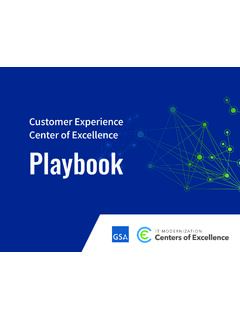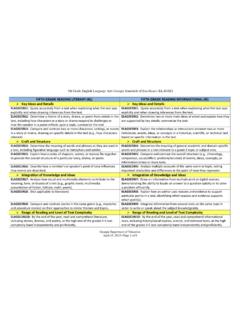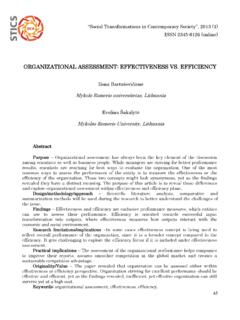Transcription of Data & Analytics Center of Excellence PLAYBOOK
1 I T M O D E R N I Z AT I O N. Centers of Excellence Data & Analytics Center of Excellence PLAYBOOK . INTRODUCTION. Building mature data Analytics organizations across government is a necessary step to achieve the Cross-Agency Priority (CAP) goal. Leveraging data as a strategic asset will increase the federal government's effectiveness, facilitate oversight, and promote transparency. The Data & Analytics Center of Excellence (CoE) drives innovation in data management, analysis and reporting for partner agencies. Its overarching goal is to enable data-driven decision making. The team developed this 10-play PLAYBOOK so agencies can lead more effective government policies and programs. While not every play will apply to your agency, they will help you strive towards more data-driven decisions.
2 The Data & Analytics CoE developed this PLAYBOOK according to relevant laws, policies, and guidance, including the newly released Federal Data Strategy and OMB. Circular A-11. The relevant directives provide the fundamental framework by which the CoE conducts discovery and implementation. Data & Analytics PLAYBOOK 1. KEY CONCEPTS. Throughout this document, we will refer to the following key concepts: Advanced Analytics - Using tools and technologies to predict future trends ( , predictive data and Analytics , data mining, and artificial intelligence (AI) efforts). Data Culture - organizational investment in data and Analytics capacity; cultivation of an environment where all staff are encouraged to use data to make key decisions. Data Governance - The practice of data management to ensure high data quality.
3 Key focus areas include data availability, usability, integrity, and security. Data Infrastructure - Collection of technologies ( , hardware, software, cloud services) used for data sharing and utilization. Data Visualization - Using visual elements ( , charts or graphs) to quickly consume key information. Technical Infrastructure - Collection of hardware, software, networks, cloud resources, data centers, etc., used to support information technology (IT) services. Data & Analytics PLAYBOOK 2. DATA & Analytics PLAYS. Define a Vision PLAY 1. Obtain Leadership and Stakeholder Commitment PLAY 2. Evaluate the Current State PLAY 3. Develop Future State Requirements PLAY 4. Conduct a Gap Analysis PLAY 5. Create an Implementation Roadmap PLAY 6. Establish a Data Governance Structure PLAY 7.
4 Create an Enterprise Data Model PLAY 8. Emphasize Rapid Prototyping PLAY 9. Embrace Continuous Process Improvement PLAY 10. Play 1 DEFINE A VISION. Define a clear and realistic vision of your organization's near-term and long-term goals for data and Analytics . You'll be able to assess the maturity level of your organization's data and Analytics . CHECKLIST KEY QUESTIONS. At a high level, document the types of concrete Who are your main internal and external outcomes that would contribute to mission success customers? Develop and continue to refine the What are their primary business goals? overarching vision statement and conceptual framework to explain what data and What data limitations keep your organization from Analytics could mean to the organization, in both achieving success?
5 The near and long-term What key improvements do you intend to achieve in Are all key mission areas involved in defining the the near-term as well as long-term? vision? What sort of data culture exists in your organization? How does data culture align with your vision? What does success look like? Data & Analytics PLAYBOOK 4. Play 2 OBTAIN LEADERSHIP & STAKEHOLDER COMMITMENT. Obtaining stakeholder buy-in early ensures that participants understand desired outcomes and the requirements to achieve those outcomes. This buy-in requires a more open and transparent approach to exposing data and a decision-making structure that emphasizes the important role of, and improvement to, the tools that support it. CHECKLIST KEY QUESTIONS. Develop an introductory document with a Who are the key organizational stakeholders?
6 High-level vision, project scope, and timeline Did you include at least one executive or decision-maker from every core business area? Align project scope with the organization's vision Does each team understand its roles/responsibilities? Document high-level outcomes without Do the stakeholders share a cohesive vision? listing overly prescriptive deliverables or achievements Is there a clear and effective management structure to coordinate and enable data-related or data-dependent Involve leadership from all key areas: IT, projects across the organization? business lines, communications, web, customer service, human resources, and Does the team agree about the outcomes and their finance feasibility? Set realistic expectations for progress Have you identified data champions within the organization who can engage across teams?
7 Ensure sustained commitment from leadership Provide regular updates on progress, challenges, and next steps Data & Analytics PLAYBOOK 5. Play 3 EVALUATE THE CURRENT STATE. A current state analysis involves reviewing existing business functions, activities, and technology implementations that the business has either already carried out or plans to carry out. Assess current technical infrastructure and stakeholder roles in existing business processes to evaluate success areas, areas of improvement, and challenges. CHECKLIST KEY QUESTIONS. Conduct interviews and workshops with Who are your organizational stakeholders? leadership and program-level staff to identify the key workflows, stakeholders, technology, and Who are your customers and end users? systems Who are the most competent subject-matter experts (SMEs).
8 Develop workflows outlining the current systems, process flows, platforms, and application portfolio in your organization for given data assets or Analytics applications? Capture how current system owners interact with existing business processes or data systems, What are your data assets ( , databases)? current data and Analytics -related policies, and standards What is your technical infrastructure? Document stakeholder-identified success areas What are the processes currently used to manage data and pain points or challenges that impede their flows? work Who owns them? Document similarities and common systems across business functions Is there existing documentation? Assess the skills that employees acquire through on-the-job training that add value to the What are the current training processes?
9 Organization ( , human capital assessment). Is the training's impact being monitored? What do data and Analytics practices across major mission areas look like? Are there planned technology acquisitions or staff hires? Data & Analytics PLAYBOOK 6. Play 4 DEVELOP FUTURE STATE REQUIREMENTS. The future state requirements define what the organization's data and Analytics structure would ideally look like, based on leadership's vision and strategic goals. CHECKLIST KEY QUESTIONS. Do not be constrained by the existing What business units have a high citizen state when considering an ideal, engagement? target state. What data process improvements do you need to improve Develop a list of desired future state organizational efficiency? requirements that map to the vision: systems capabilities, Key Performance Indicators Would more datasets or reporting would support improved (KPIs), process flows, platforms, applications, decision making?
10 Analytics techniques ( , data visualization, artificial intelligence (AI), operations research, What datasets or reporting do you need? etc.), and personnel capabilities What business units are candidates for Consider what types of roles would have modernization through advanced Analytics such as access to which types of data at various points predictive Analytics ? within processes What skills does your team need to adequately support Define a plan to track the impact of technical infrastructure? training on data and Analytics Can you use existing platforms to support current business functions? Data & Analytics PLAYBOOK 7. Play 5 CONDUCT A GAP ANALYSIS. The gap analysis is intended to identify the people, processes, and technologies that are required to move from the current state to the target state.


